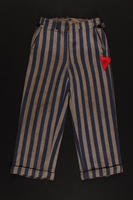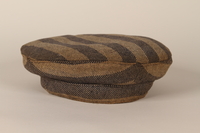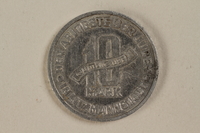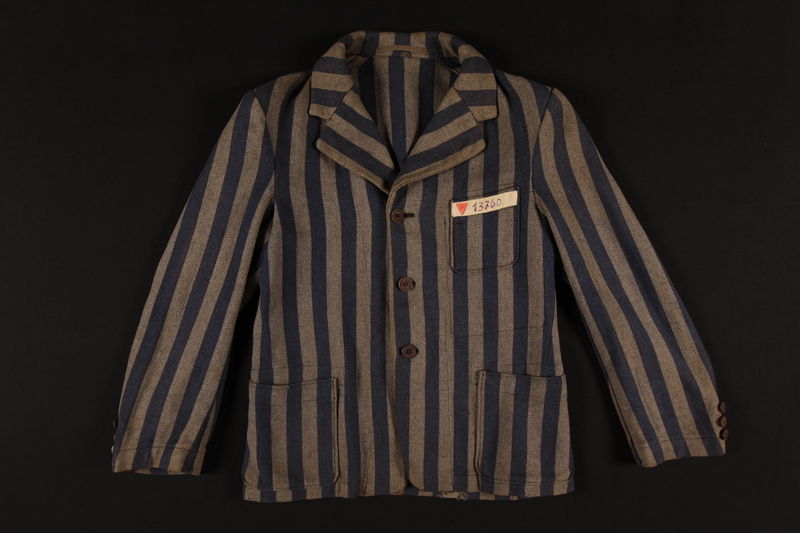Overview
- Brief Narrative
- Striped concentration uniform jacket worn by Mieczyslaw Watnicki in Auschwitz concentration camp from late 1940 until his liberation in Germany in May 1945. The jacket breast has a white patch with an inverted red triangle with a P and the number 13760., one digit off from Mieczyslaw's number 137605. The red triangle with P indicates a Polish political prisoner. After Germany invaded Poland in September 1939, Mieczyslaw lived in Warsaw under a false identity as a non-Jew. He was arrested in late 1940 for falsifying identity papers, but the Gestapo did not discover that he was Jewish. He was sent to Auschwitz as a Polish political prisoner and assigned prisoner number 137605. In late 1944 or early 1945, Mieczyslaw was sent to Oranienburg slave labor camp in Germany. He was later sent to Sachenhausen, Porta Westfalica, Stendal, Fehrbellin, and Ludwigslust, likely on a death march. Mieczyslaw was liberated in May 1945. Mieczyslaw’s wife, parents and four siblings were killed in the Holocaust. He immigrated to America in 1950. He became friends with Leon Ginsburg and at some point, entrusted him with his concentration camp uniform. Ginsburg, as a child, survived the Holocaust in hiding in Poland and Ukraine.
- Date
-
use:
approximately 1940-1945 May
- Geography
-
issue:
Auschwitz (Concentration camp);
Oświęcim (Poland)
use: Sachsenhausen (Concentration camp); Sachsendorf (Wurzen, Germany)
use: Porta Westfalica (Concentration camp); Porta Westfalica (Germany)
use: Fehrbellin (Concentration camp); Fehrbellin (Germany)
use: Ludwigsdorf (Concentration camp); Ludwikowice Klodzkie (Poland)
- Credit Line
- United States Holocaust Memorial Museum Collection, Gift of Leon Ginsburg
- Contributor
-
Subject:
Marek Watnicki
Subject: Leon Ginsburg
- Biography
-
Mieczyslaw Watnicki was born on December 25, 1915, in Warsaw, Poland, to a Jewish couple, Henryk and Regina Brunen Watnicki. Mieczyslaw, also called Mietek, had four siblings: Jurek, Wladyslaw, called Adolf, born circa 1914, Marian, born on January 18, 1918, and a sister. Mieczyslaw and his three brothers worked with their father in his pharmacy. Wladyslaw married Faiga Grodzicka, also called Felicia. They had a daughter, Marysia, on October 23, 1934. Mieczyslaw’s oldest brother Jurek also married and had a daughter.
On September 1, 1939, Germany invaded Poland. German troops entered Warsaw on September 29. Mieczyslaw’s father Henryk had recently died and all of Mieczyslaw’s siblings were in Warsaw to mourn. The Germans segregated the Jewish population in a ghetto beginning October 1940. Mieczyslaw and Wladyslaw made false identification papers as non-Jews and did not enter the Warsaw ghetto. Wladyslaw’s wife and daughter did go to ghetto. Mieczyslaw made false identity papers for Wladyslaw’s daughter, Marysia, and arranged for her to escape under the ghetto fence. Wladyslaw and Marysia left Warsaw and went into hiding under assumed identities in Opoczno. In late 1940, Mieczyslaw was arrested in Konskie for falsifying identity papers at a university in Warsaw. The Gestapo did not know that Mieczyslaw was Jewish. He was sent to Auschwitz concentration camp as a Polish political prisoner and assigned prisoner number 137605. As a Polish prisoner, Mieczyslaw was able to send and receive letters. He corresponded with Wladyslaw as well as his sister Marian. Wladyslaw sent him food and updated him on the location of his daughter, Marysia. He had sent Marysia to work in Germany under a false identity. Mieczyslaw promised to find Marysia and care for her if he survived the war. Through the correspondence, Mieczyslaw learned that their mother Regina died in 1943. In late 1944 or early 1945, Mieczyslaw was sent to Oranienburg slave labor camp, a subcamp of Sachenhausen concentration camp, in Germany. He was later sent to Sachenhausen, Porta Westfalica, Stendal, Fehrbellin, and Ludwigslust, likely on a death march. Mieczyslaw was liberated in May 1945.
Mieczyslaw looked for his niece Marysia and learned that her foster family had taken her to Poland. When he found her, her Polish foster family would not let her leave. Marysia snuck out in the middle of the night and fled with Mieczyslaw. They went to Luenburg displaced persons camp in Germany. The rest of Mieczyslaw’s family was killed in the Holocaust, including his parents and four siblings. Mieczyslaw began a relationship with Maria Ackerman Plech (1919-2011). In 1942, Maria left her infant daughter Elke in the care of a Polish family and was sent to Germany as a Polish Catholic forced laborer. She was liberated in 1945. Maria’s husband, Moses Plech, was killed in the Holocaust. Mieczyslaw sent his niece Marysia to an orphanage, where she had a better chance of immigrating to Palestine or the United States. Mieczyslaw went to Poland with Maria and helped her regain custody of her daughter. The family returned to Luenburg, where Mieczyslaw had a wholesale business. Mieczyslaw and Maria were married on February 28, 1948. They had a daughter Reni, later called Lisa, in 1949. In September 1949, Mieczyslaw’s niece Marysia immigrated to the US and changed her name to Marie. On May 22, 1950, Mieczyslaw, his wife Maria, and their two daughters sailed from Bremerhaven on the USS General W. M. Black, arriving in New York on May 31. The family settled in New York. Mieczyslaw and Maria changed their first names to Marek and Marie. Marek worked as a barber. Marek, 65, died on February 15, 1981.
Noah Ginzburg was born on June 12, 1932, in Maciejow, Poland (now Lukov, Ukraine), to an Orthodox Jewish couple, Kalman and Pesia Goldberg Ginzburg. Noah, called Noikele, had two siblings: Blima, called Blimele, born in 1928, and Tzvi Hershel, born in 1930. Noah’s maternal grandmother, Bela Goldberg, lived with them. His paternal grandparents, Yakov and Perel Ginzburg, had a large house nearby. Noah’s parents owned a fabric store. Noah’s father Kalman died circa 1934. Noah attended a Polish school in the mornings and a Jewish school in the afternoons. He spoke Yiddish, Polish, and Ukrainian.
On September 1, 1939, Germany invaded western Poland. Noah saw Polish soldiers who had fled east. On September 17, the Soviet Union invaded and occupied eastern Poland, including Maciejow. Noah’s school became a Soviet school. The Soviets took the family store, but Noah’s mother Pesia stole some fabric. On June 2, 1941, Germany attacked the Soviet Union and the Soviet troops fled east. The German troops were eventually replaced by the Einsatzgruppen. They ordered all Jewish men aged 16 to 60 to report to the town square. All the men who reported did not return. The Germans said they were sent away to work, but Noah heard the shooting. Antisemitic restrictions were established. There was a curfew of 6 PM. Jewish homes were marked with yellow circles and Jews had to wear Star of David armbands. Noah did not wear one because he was too young. He volunteered to get water from the well instead of Blima and Hershel, who might be taken for labor. Noah’s family bartered for food from the farmers with the fabric stolen by Pesia.
In early 1942, Noah’s family went to his paternal grandparent’s house. They built a hiding place in the attic. Noah, Hershel, and their grandfather stayed in the house and their mother, sister, grandmother, and three paternal aunts hid in the attic. A German officer came to the house and looked for Noah’s aunts, but did not find the hiding place. After about ten days, the round-ups and killings stopped and Noah and his family returned home. In September, Noah’s mother Pesia was warned that the Germans were going to kill all the Jews. They went into hiding in a store basement with about 50 other people. The next day, they heard shooting outside. Leon and Hershel looked out a window and saw the Germans shoot a woman. A young girl was crying and people were afraid they would be discovered because of the noise. Her mother put her upstairs in a bed to sleep. On September 20, the girl was discovered by a Ukrainian policeman. She led him to the entrance of the hiding place. While everyone was being taken out of the basement, Pesia hid Noah behind the boards of a boarded up window. She hid under some bedding. When the police searched the room, they stabbed the bedding with their bayonets and injured Pesia. They took her away but did not find Noah. The head of the Judenrat eventually came into the basement. Noah followed him out and they hid in the attic. A policeman found and arrested the man but did not find Noah.
Noah knew that his Hebrew teacher had built a hiding place in his house. Noah went to his house and found the teacher and his family hiding behind a false wall. They allowed Noah to hide with them. The next day was Yom Kippur and they fasted. When they ran out of food, Noah volunteered to get more. He was caught on the way back by a Ukrainian boy from school, but he let Noah go. After a week in hiding, the house was searched and the hiding place was discovered. Noah escaped out a window but everyone else was captured. Noah left Maciejow and walked to a farmer who was friends with his grandfather. He told Noah to go to the ghetto in Luboml, where Noah had relatives. In the ghetto, Noah was taken to his uncle, Falek Ginzburg. The next day, Noah’s brother Hershel arrived. When all the Jews in Maciejow were rounded up and put in a building, Hershel escaped out the chimney. In early October, the Germans started rounding up the Jews in Luboml. Noah and Hershel went into a hiding place in the house with several other people. The next day, a man left the hiding place to get water and was discovered by two Ukrainian policemen. They demanded gold and money. Noah and Hershel escaped out a window and hid in the attic of the next building. One of their cousins found them and told them where to meet her to flee Luboml that night. Noah and Hershel split up to find food and Hershel was captured by the Germans.
Noah met up with his cousins and left Luboml. They traveled at night and hid during the day. After a few nights, a man with a rifle rode by on his bicycle, so Noah hid in a ditch beside the road. The Ukrainian militia arrived and captured his cousins. Noah crawled into a drain pipe and was not discovered. The next morning, Noah walked to a farm and hid in a haystack. He was discovered by the farmer, who had known his uncle Falek. They told Noah his cousins had been killed and let him stay until nightfall. Noah went to a farmer who had bartered with his mother. He hid in the woods during the day and the barn at night. In winter 1942, Noah briefly lived in another ghetto, then went to a different farm. The farmer hid him in exchange for a watch. In spring 1943, Noah found work pasturing cows for a Polish farmer he knew, Jan Huber. In the summer, Ukrainians began attacking Polish families. Noah and Jan’s family went to Maciejow to register as Polish refugees with the German authorities. Jan registered Noah as Stanislaw Kwiatkowski, a Polish Catholic orphan whose parents had been killed by Ukrainians. In May, the Germans sent them to Chelm. Jan helped Noah get a job with the mayor of a nearby town, who got Noah official papers as Stanislaw Kwiatkowski. In April 1944, another worker saw that Noah was circumcised so he returned to Chelm. Jan helped him get several jobs at other farms in Strachoslaw in the spring and summer. In August, Noah was liberated in Chelm by Soviet forces.
One of Noah’s paternal aunts found him in Chelm. Another aunt had also survived and was living in the Soviet Union. Noah went to live with her and worked at the Nosowka sugar factory. Most of Noah’s family was killed during the Holocaust. His mother, Pesia, and sister, Blima, were murdered by the Einsatzgruppen on September 20, 1942. His brother Hershel was killed after he was captured in October 1942. His grandparents also perished. In May 1945, Noah returned to Luboml. In August, Noah went to Stetin. In December 1945 or January 1946, Noah went to Berlin, Germany. He changed his name to Leon. In February, he went to Fohrenwald displaced persons camp near Munich. He spent the summer at an ORT trade school in Berlin, then returned to Fohrenwald. On December 9, 1946, Leon sailed from Bremen, Germany, on the SS Marine Marlin, arriving in New York on December 20. He traveled with a group of orphans. Leon lived with his grandfather’s sister in Brooklyn. He got a degree in electrical engineering from City College. On December 28, 1958, Leon married Betty Hellner (b. 1938). They settled in Tappan, New York. In 1962, Leon opened a dental equipment company. Leon and Betty had three children. Leon, 81, died on March 10, 2014.
Physical Details
- Classification
-
Clothing and Dress
- Category
-
Concentration camp uniforms
- Object Type
-
Jackets (lcsh)
- Physical Description
- Blue and gray vertically striped, hip length, long sleeved cotton jacket with slightly cinched cuffs with 3 brown stained wooden buttons and 2 gray cloth covered shoulder pads. It has a pointed notched collar with lapels with black triangles stitched along the seam and a short, hand sewn hem along the collar edge. The front opening has 3 larger wooden buttons on the right, 3 finished buttonholes on the left, and full length plackets, pieced at the slightly curved, rounded bottom corners. There is a small patch pocket on the left breast pocket. There is a large patch pocket at both hips; above the pocket edge on the inside is a strip of cloth, with the stripe horizontal, with a finished top edge and a frayed bottom edge - possibly reinforcement or the remainder of an interior pouch pocket. There is a large striped cloth patch pocket on the interior left breast. There are vertical side darts for shaping and, on the interior, a striped cloth channel across the waist area with a white cloth string to adjust the waist size. There is a gray cloth hanging loop on the interior neck band. The armhole seams have gray cloth binding and all seams are neatly finished. A rectangular white cotton patch, 3.750 in., with a hand drawn inverted red triangle with a small letter P inside next to the numeral 13760. written in blue marker is handstitched with white cotton thread to the breast pocket. The gray cloth stripes have diagonal white threads. The cloth is stained, with remnants of white paint on the interior and exterior, holes, and repairs. The jacket is very well tailored overall with many custom details. It seems sized to fit a smaller statured person.
- Dimensions
- overall: Height: 24.875 inches (63.183 cm) | Width: 16.750 inches (42.545 cm)
- Materials
- overall : cotton, wood, thread, ink, paint
- Inscription
- front, left breast, white patch, handwritten, black ink : (P on inverted red triangle) 13760. [Polish]
Rights & Restrictions
- Conditions on Access
- No restrictions on access
- Conditions on Use
- No restrictions on use
Keywords & Subjects
- Topical Term
- Concentration camp inmates--Uniforms. Holocaust survivors--United States. Holocaust, Jewish (1939-1945)--Poland. Jews--Persecution--Poland. Political prisoners--Poland. Slave labor--Germany. World War, 1939-1945--Prisoners and prisons, German.
- Geographic Name
- Poland--History--German occupation, 1939-1944.
Administrative Notes
- Legal Status
- Permanent Collection
- Provenance
- The concentration camp jacket was donated to the United States Holocaust Memorial Museum in 1993 by Dr. Leon Ginsburg.
- Funding Note
- The cataloging of this artifact has been supported by a grant from the Conference on Jewish Material Claims Against Germany.
- Record last modified:
- 2022-07-28 18:22:12
- This page:
- https://collections.ushmm.org/search/catalog/irn7298
Also in Marek Watnicki collection
The collection consists of a concentration camp uniform cap, jacket, and pants, and Łódź ghetto coin relating to the experiences of Mieczyslaw (Marek) Watnicki during the Holocaust when he was in Auschwitz concentration camp in German occupied Poland.
Date: approximately 1940-1945

Concentration camp uniform pants with red triangle patch worn by Polish Jewish inmate
Object
Striped blue and gray concentration uniform pants worn by Mieczyslaw Watnicki in Auschwitz concentration camp from late 1940 until his liberation in Germany in May 1945. The pants have a red inverted triangle badge with the letter P on the upper left thigh. This would indicate that Mieczyslaw was a Polish political prisoner. After Germany invaded Poland in September 1939, Mieczyslaw lived in Warsaw under a false identity as a non-Jew. He was arrested in late 1940 for falsifying identity papers, but the Gestapo did not discover that he was Jewish. He was sent to Auschwitz as a Polish political prisoner and assigned prisoner number 137605. In late 1944 or early 1945, Mieczyslaw was sent to Oranienburg slave labor camp in Germany. He was later sent to Sachenhausen, Porta Westfalica, Stendal, Fehrbellin, and Ludwigslust, likely on a death march. Mieczyslaw was liberated in May 1945. Mieczyslaw’s wife, parents and four siblings were killed in the Holocaust. He immigrated to America in 1950. He became friends with Leon Ginsburg and at some point, entrusted him with his concentration camp uniform. Ginsburg, as a child, survived the Holocaust in hiding in Poland and Ukraine.

Concentration camp uniform cap worn by a Polish Jewish inmate
Object
Striped concentration uniform cap worn by Mieczyslaw Watnicki in Auschwitz concentration camp from late 1940 until his liberation in Germany in May 1945. The pants have a red badge with the letter P, indicating that Mieczyslaw was a Polish political prisoner. After Germany invaded Poland in September 1939, Mieczyslaw lived in Warsaw under a false identity as a non-Jew. He was arrested in late 1940 for falsifying identity papers, but the Gestapo did not discover that he was Jewish. He was sent to Auschwitz as a Polish political prisoner and assigned prisoner number 137605. In late 1944 or early 1945, Mieczyslaw was sent to Oranienburg slave labor camp in Germany. He was later sent to Sachenhausen, Porta Westfalica, Stendal, Fehrbellin, and Ludwigslust, likely on a death march. Mieczyslaw was liberated in May 1945. Mieczyslaw’s wife, parents and four siblings were killed in the Holocaust. He immigrated to America in 1950. He became friends with Leon Ginsburg and at some point, entrusted him with his concentration camp uniform. Ginsburg, as a child, survived the Holocaust in hiding in Poland and Ukraine.

Łódź (Litzmannstadt) ghetto scrip, 10 mark coin
Object
10 mark Litzmannstadt coin owned by Mieczyslaw Watnicki, although when or how he acquired it is unknown. This type of coin was issued in Łódź Ghetto in German occupied Poland in 1943. Currency was not allowed in the ghetto, and scrip was issued for use only there. After Germany invaded Poland in September 1939, Mieczyslaw lived in Warsaw under a false identity as a non-Jew. He was arrested in late 1940 for falsifying identity papers, but the Gestapo did not discover that he was Jewish. He was sent to Auschwitz as a Polish political prisoner and assigned prisoner number 137605. In late 1944 or early 1945, Mieczyslaw was sent to Oranienburg slave labor camp in Germany. He was later sent to Sachenhausen, Porta Westfalica, Stendal, Fehrbellin, and Ludwigslust, likely on a death march. Mieczyslaw was liberated in May 1945. Mieczyslaw’s wife, parents and four siblings were killed in the Holocaust. He immigrated to America in 1950. He became friends with Leon Ginsburg and at some point, entrusted him with his concentration camp uniform. Ginsburg, as a child, survived the Holocaust in hiding in Poland and Ukraine.




